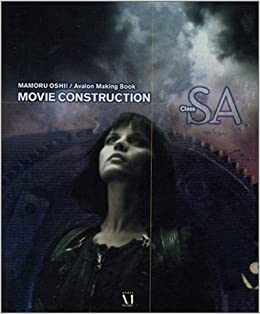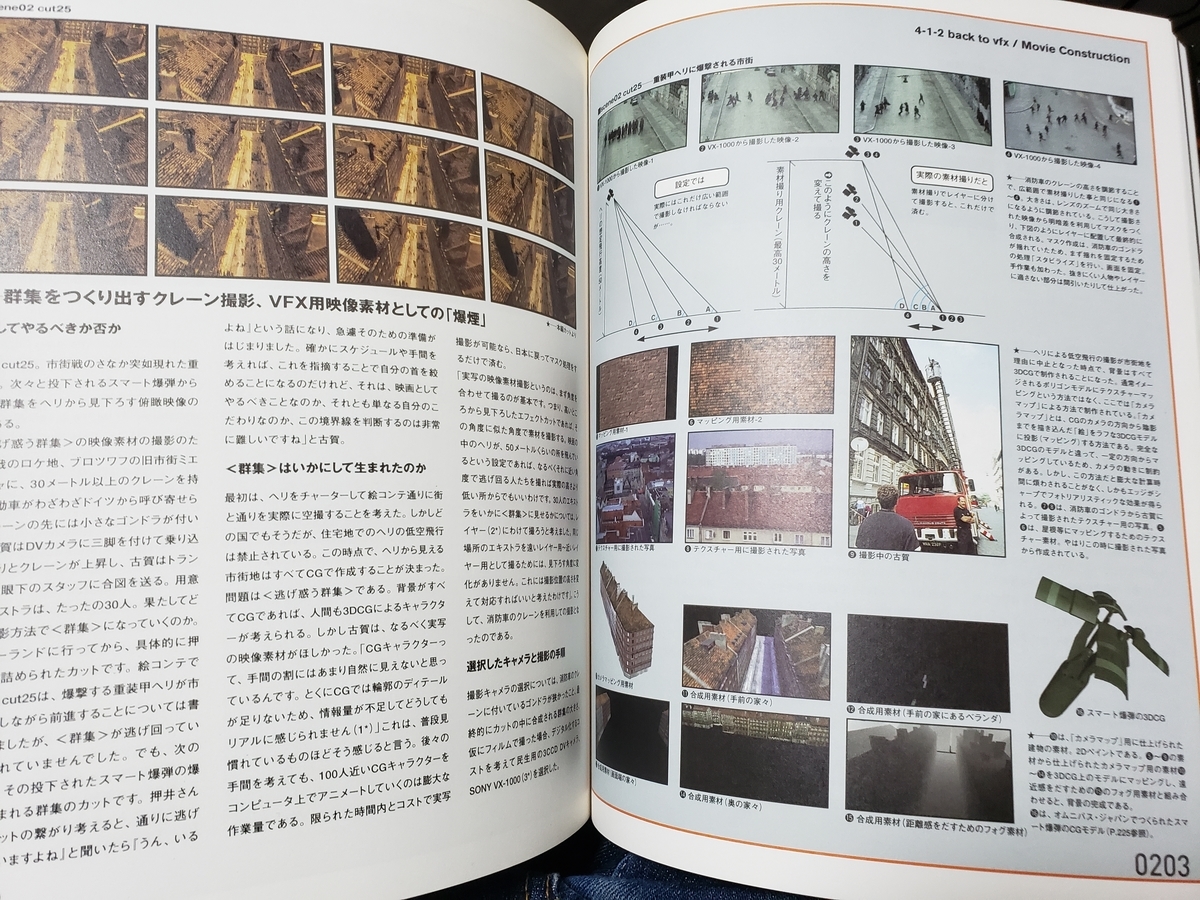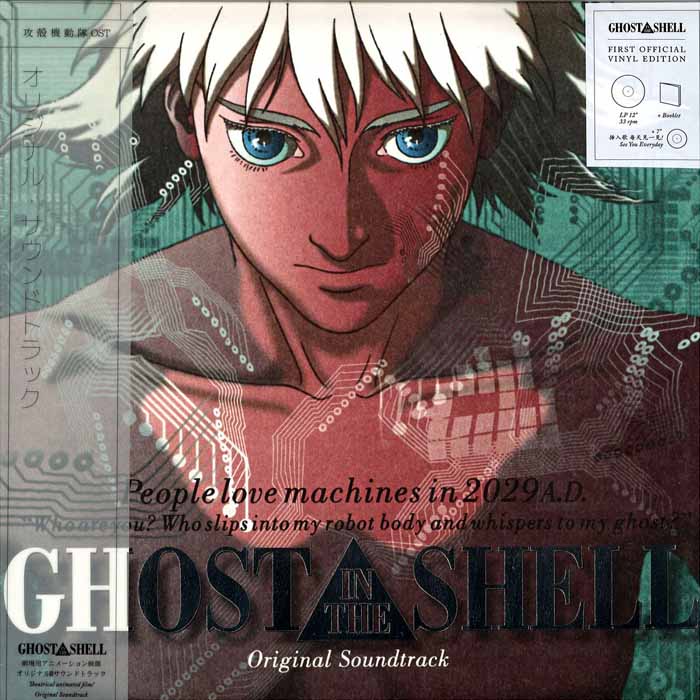
I think that the lyrics of this iconic anime song tend to be misunderstood. Here are my thoughts on the lyrics.
The original lyrics
吾が舞へば
麗し女 酔ひにけり
吾が舞へば
照る月 響むなり
結婚に 神天降りて
夜は明け 鵺鳥鳴く
Since I danced
the beautiful lady was enchanted
Since I danced
the shining moon echoed
Proposing marriage, the god shall descend
The night clears away and the night bird will sing
*"To-kami-emi-tame" from Utai III is a very symbolic part, but I skip it in this article. First of all, its origin is very different from the other parts. Plus, it is a bit difficult to analyze that part.
Background
*from the liner notes of the soundtrack CD
- When they started recording the soundtrack, Kawai didn't have any good ideas. The only thing he had decided on was to use traditional drums. As Kawai played the drums incessantly on the first day, he wondered, "Is this okay?"
- When Oshii first heard the vocals, he felt confident about the soundtracks.
- The lyrics were written by Kawai. Oshii was impressed with how well Kawai summarized the story of the movie in the lyrics.
- Kawai thought that modern Japanese language would not fit the song, so he looked up ancient words in the library." Manyoshu was one of the books he read at that time.
- The idea of "To-kami-emi-tame" came from Kazunori Ito.
- Kawai says, "I reinterpreted the harmonies and voices of Bulgarian polyphony in a Japanese way."
- Oshii was inspired by the sound of the bells from the soundtracks. GitS is based on the Bible, but the bell sounds reinforce the Shinto feel. Although Oshii did not intend this from the beginning, he thought that the bell added the omnipresence of Yaoyorozu's gods to the film.
Premises
- Kawai wrote the lyrics. He was inspired by some ancient texts.
- Kawai picked some words from Manyoshu. He also used some words from other ancient text.
- It is a summary of GitS' story.
Preparatory research
I researched keywords on Makoto Yoshimura's Manyoshu database.
The keywords are
まへば, くはしめ, ゑひにけり, てるつき, とよむなり, よばひ, あまくだり, よはあけ, ぬえどり
Some words are conjugated.
あが まへば/ since I dance
"Dance" appears in some poems from Manyoshu, but the exact phrase doesn't. As I explain later, I think it was inspired by Nihon Shoki.
くはしめ/ beautiful lady
くはし/ beautiful often appears in Manyoshu, but "くはしめ"/beautiful lady appears only once. It's a long poem.
...くはし妹に 鮎を惜しみ...
...since I didn't give the sweetfish to my lovely wife...
It is a fisherman's poem of mourning over his wife's death. "妹"(me) means woman in general, so it doesn't necessarily mean wife in other cases.
The poem's theme is not related to GitS's theme.
ゑひにけり/ was enchanted
酔/"drunk" appears in Manyoshu, but 酔ひにけり/ "was drunk" appears only once:
焼太刀の かど打ち放ち 大夫の 寿く豊御酒に 我れ酔ひにけり
When we drew a sword in the ritual party, I found myself drunk by good sake.
In this poem, 酔ふ simply means to get drunk. Kawai interpreted it as "enchanted by the dance". I think that's Kawai's original rhetoric. It doesn't appear in ancient texts as far as I know.
The auxiliary "に" (a conjugated form of ぬ) means perfect tense or "ended up". The auxiliary verb "けり" means hearsay past and discovery/admiration. And thus, 酔いにけり means "I found myself drunk".
てる つき/ shining moon
That phrase appears so often because the moon is a very common material in the traditional poem. Manyoshu contains more than 100 poems about the moon. It has more than 20 poems even for "てるつき"/ shining moon.
The shining moon can symbolize various things, like a bow, party night, eternity, ephemerality, guidance, etc. It symbolizes lovers in many poems. In the ancient era, men used to visit their girlfriends'/ wives' houses at night. (It is called 妻問婚 or 通い婚.) And thus, the moon symbolized their romantic time (or distant lovers.) On the other hand, cloud and morning sunshine symbolized temporary separation and sorrow.
Plus, it is sometimes compared with mirrors, which is another important theme of GitS.
朝日影 にほへる山に 照る月の 飽かざる君を 山越しに置きて
Like the remaining moon behind the morning mountain, I have to leave you behind.
まそ鏡 照るべき月を 白栲の 雲か隠せる 天つ霧かも
The moon should shine like a mirror, but it is now hidden by a cloud or a fog.
とよむ/ echo
It often appears because it is related to birds. Birds' chirps or mountain echoes are used in many poems. As far as I researched, it is not related to the moon in Manyoshu. I suppose "the shining moon echoed" is Kawai's rhetoric.
"響むなり" appears only once in Manyoshu:
巨椋の 入江響むなり 射目人の 伏見が田居に 雁渡るらし
A sound echoes over Lake Ogura. Geese fly to Fushimi rice field, where hunters lie down on.
よばひ/ marriage, calling
It often appears in Manyoshu.
As I already explained, ancient Japanese people used to visit their girlfriends' houses at night. That is a common process of marriage. The same word also means to call someone. I found 8 poems in Manyoshu, and 4 of them mean just to call someone.
In GitS's context, it means marriage and spiritual fusion.
他国に よばひに行きて 大刀が緒も いまだ解かねば さ夜ぞ明けにける
I visited a lover in a foreign country, but the dawn broke even before I wore off the sword cord.
あまくだり/ (the god shall) descend
天降り can be read as both "あまくだり" and "あもり". It should be read as "あもり"(amori) in Manyoshu, but both of them mean the same thing.
In most cases, it means Tenson Korin: a myth of the emperor/ tenno's lineage.
Ninigi, a grandson of the sun god, descended to the human land. Amaterasu gave him the three treasures at that time. The imperial family is descendants of Ninigi. The myth tells the noble lineage of the emperors.
The three treasures include Yata-no-Kagami, the mirror that reflected Amaterasu's face in Amano-Iwato. The mirror and descendence. Two important elements appear in this part. Angel's descent was reinterpreted into Ninigi's descent, and by doing that, the descent theme and the mirror theme are linked together.
天降りつく 天の香具山 霞立つ...
When the spring comes and Ame-no-Kaguyama, the mountain of the god's descent, is veiled in the mist...
よは あけ/ the night clears away
Manyoshu includes so many poems about nights. I found dawn (night clears away) in 10 poems, and 7 of them are poems about sorrows of separation. As I explained in the shining moon part, dawn used to symbolize separation from lovers.
It also implies Ama-no-Iwato myth in the lyrics.
暁と 鶏は鳴くなり よしゑやし ひとり寝る夜は 明けば明けぬとも
The first cockcrow says it's morning, but I don't care. It was a lonely night, anyway.
ぬえとり/ night birds or scaly thrush
It is read as ぬえどり(Nuedori) in Manyoshu.
Some websites translate it as "chimera bird", but that is very misleading.
ぬえ (Nue) originally meant birds that sing sorrowfully at night. Ancient people regarded the song as a bad omen. They assumed that Nue is scaly thrush.
Nue came to mean a chimera-like monster in the 14th to 15th centuries. In The Tale of Heike, a famous samurai slew a chimeric monster. That monster had a Nue-like voice, but it didn't have a name. That's why it was called Nue later.
In the lyrics of Utai, it obviously means night birds, not the chimeric monster.
Manyoshu covers six poems about nue. In most of those poems, Nue/ night birds/ scaly thrush symbolize sorrows of separation or unrequited love. Since their sorrowful songs were heard at night, people linked it to sad separations.
久方の 天の川原に ぬえ鳥の うら歎げましつ すべなきまでに
Zhinü cries like a scaly thrush beside the milky way since she can't do anything else after the rendezvous.
Development
Oshii said that the lyrics of Utai are a summary of GitS's story. We need to consider that aspect.
In "Mechaphilia", Oshii explained the design of TO8A2 (the spider-like tank). In this essay, he mentioned the mythical aspects of GitS movie.
Spiders are divine entities even in foreign myths. In Nihon Shoki, Sotoori-no-Iratsuhime composes a poem:
"My lover must come to see me tonight. The spider at the foot of bamboo tells that to me."
Motoko is Ame-no-Uzume, a shaman who dances on the tank (the tub) to bring back Puppet Master (Amaterasu). She can't open the hatch (Ama-no-Iwato), but Batou (Ame-no-Tajikarao) comes there. It is a very Japanese story. However, the background environment is the Christian church-like museum. Even the angel appears, and the sound of the AP bullets (the metaphorical sound of the church bell) comes into the fusion (marriage) moment. Since the story is set in a chaotic world with little nationality, the mythical background is chaotic as well.
Oshii brought up two inspiration sources. The first one is Nihon Shoki, and the second one is the Ama-no-Iwato myth. Ama-no-Iwato is included in both Kojiki and Nihon Shoki.
Plus, I suppose "I dance" and "the night clears away" parts are based on Ama-no-Iwato. That's probably what Oshii means by "summary of the film".
*btw, I said I'd skip toh-kami-emi-tame in this article, but I should touch upon it in this part. Before Ame-no-Uzume's dance, Ame-no-Koyane chants "布刀詔戸言"(futonoritogoto, great chant). I suppose, toh-kami-emi-tame stems from that part.
Kojiki analysis
In this chapter, I use Aozora Bunko's data annotated by Yukichi Takeda.
1. Ama-no-Iwato, Ame-no-Uzume, and dance
Ame-no-Uzume's dance part in Kojiki is written as follows:
天の宇受賣の命 天の香山の天の日影を手次に繋けて 天の眞拆を鬘として 天の香山の小竹葉を手草に結ひて 天の石屋戸に覆槽伏せて 蹈みとどろこし 神懸りして 乳を掛き出で 裳の緒を陰に押し垂りき
Ame-no-uzume began a thunderous dance on an overturned tub, and divinely possessed, she exposed her breasts and lowered her skirt string to her genitals.
(Ama no Iwato (Cave of Heaven) - Japanese Wiki Corpus)
Ame-no-Uzume dances, but "儛ふ" or "儛ひ" is not used in the sentence. "儛へば" doesn't appear in other parts. Then, where did Kawai find the phrase "あが まへば"/ since I dance?
That question leads us to another source material. In Nihon Shoki volume 16, Okenosumera reveals his noble lineage and becomes Emperor Kenzo. At a party, he dances and sings his identity. That poem includes this sentence:
...あしひきの 此の傍山に 牡鹿の 角挙げて 吾が儛すれば 旨酒 餌香の市に直以て買はぬ...
...At the foot of this mountain, I dance with the deer horns on. This good sake and delicious food can't be bought even in the famous market...
(跡見群芳譜(文藝譜 「日本書紀」顕宗天皇の名告))
2. Okuninushi, Nunakawahime, and night birds
The first volume of Kojiki includes stories of Okuninushi. A goddess called Nunakawahime appears in one of those chapters. That part is important for understanding the lyrics of Utai.
After getting married with some women, Okuninushi hears that a very beautiful lady called Nunakawahime lives in Koshi. He visits her house and sings a poem in front of the house:
八千矛の 神の命は 八島国 妻娶きかねて 遠々し 高志の国に 賢し女を 有りと聞かして 麗し女を 有りと聞こして さ呼ばひに 有り立たし 呼ばひに 有り通はせ 大刀が緒も 未だ解かずて襲衣をも 未だ解かねば 嬢子の 寝すや板戸を 押そぶらひ 我が立たせれば 青山に 鵺は鳴きぬ さ野つ鳥 雉は響む 庭つ鳥 鶏は鳴く 心痛くも 鳴くなる鳥か 此の鳥も 打ち止めこせね いしたふや 天馳使 事の 語り事も 此をば
I, the god of military arts, can hardly sleep with my wife these days. Then, I heard that a wise, beautiful lady lives in the far land of Koshi. I hereby came to marry you. I don't wear off the sword cord and clothes yet. I'm still trying to break the door open. Night birds chirp in a green mountain. Voice of pheasants echoes in the yard. Even cocks crow. Oh, annoying birds. Stop chirping and crowing. The gods' messengers in the sky, tell the message to the birds.
Many familiar words appear in this poem, like 麗し女/ beautiful lady, よばひ/ marriage, 鵺/ night birds, and 響む/ echo. Kawai didn't say anything about it, but I suppose it is the main inspiration source of the lyrics.
As I already explained, night birds and dawn symbolize sorrowful separation from lovers. Okuninushi suffers from the same symbolism. Now, we understand why Kawai put night birds into the lyrics about dawn and marriage.
However, it also gives another question to us.
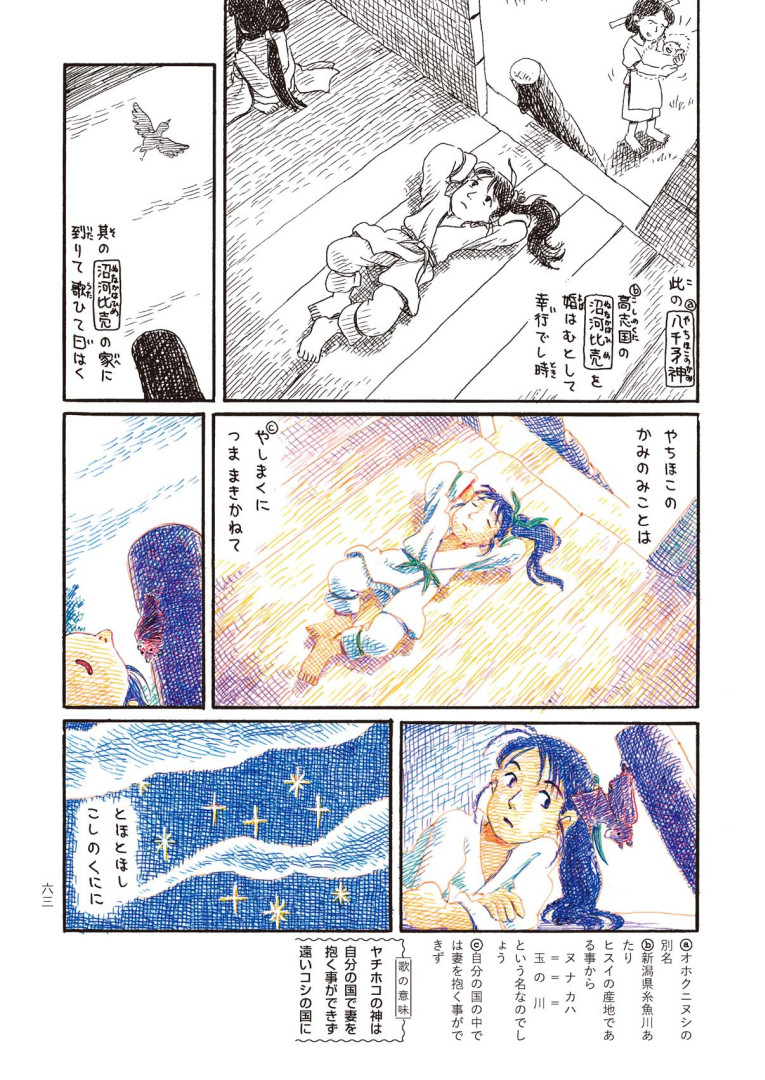

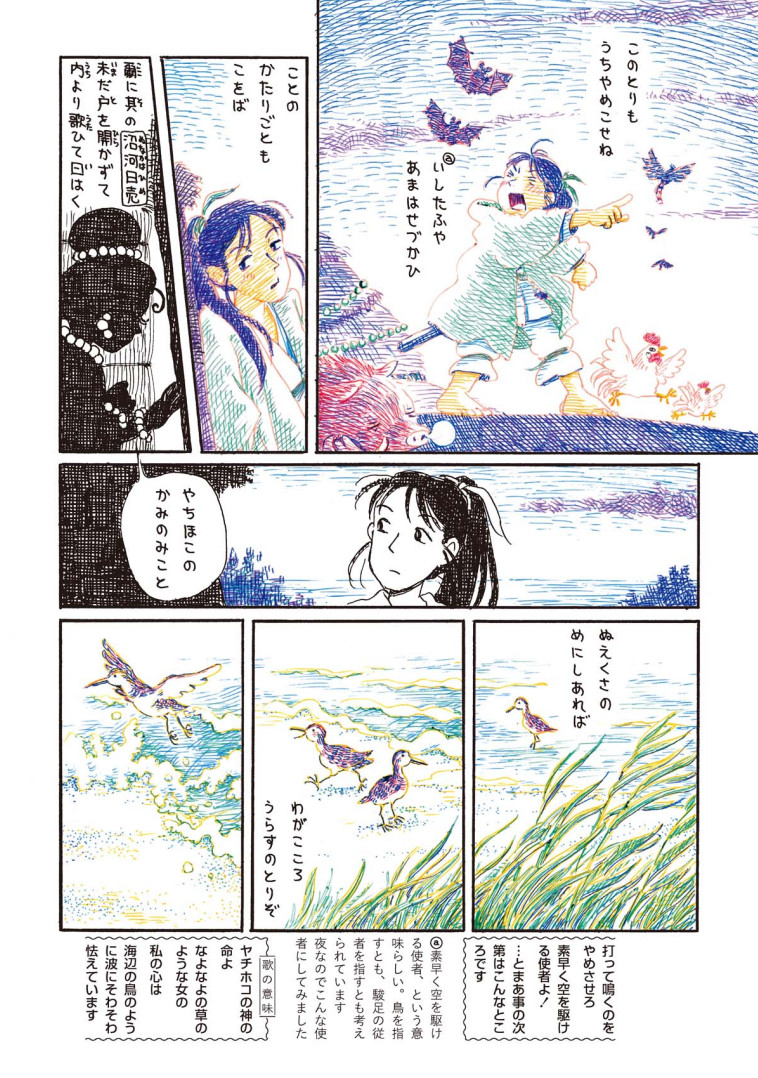
(Ballpoint Pen Kojiki by Fumiyo Kono)
Why did Kawai choose night birds?
When we look at the lyrics of Utai again, we realize that most parts can be interpreted only by using Ama-no-Iwato.
Since I danced: Ame-no-Uzume's/ Motoko's dance
the beautiful lady was enchanted: Amaterasu/ Puppet Master is enchanted by Ame-no-Uzume/ Motoko's dance.
the shining moon echoed: Amaterasu/ Puppet Master sees her mirror image/ Motoko in Yata-no-Kagami mirror (echo).
Proposing marriage, the god shall descend: The marriage/ fusion of Motoko and Puppet Master. The mirror image and self-recognition.
The night clears away: The dawn symbolizes the revival of the Sun/Amaterasu/ Motoko/ Puppet Master.
However, night birds don't fit it. Birds appear in Ama-no-Iwato story, but they are 常世長鳴鳥/ cocks. Why did Kawai use night birds instead of cocks? Why did he use the symbolic bird of separation?
In my opinion, that part represents Batou's feelings at the end of the film. When Motoko got married/ merged with Puppet Master and transcended this world, Batou was separated from her. His sadness can lead to the night bird symbol.
There is one piece of evidence for that theory. In the explanation of Batou's scene from "methods: from LAYOUTS of INNOCENCE", Oshii says this:
別れの構図、もしくは別離の予感のする構図というものがあると思います。若かりし頃、僕は師匠にそのことを聞いたことがあるのです。
「オシイ君、別れの構図って、どんなもンだと思う」
「…横位置でしょうか」
「縦位置だ。互いに背を向けた縦位置こそ別れの予感に満ちた構図なんだよ」
お前はまだ若い、修行が足らん…ということなのでした。
で、まぁ修行を重ねて編み出した構図とは、前回の「攻殻」のラストの構図、俯くバトーを背後に毅然とした素子の正面のアングルだったのですが...
I believe that there is a composition of separation or a composition of premonitory separation. When I was young, I learned that from my master (Hisayuki Toriumi).
"Oshii-kun. What do you think is the composition of separation?"
"Well, is that a plane composition?"
"No, it is a composition of depth. Two characters turn their back on each other in two different layers. That composition represents premonitory separation."
He told me that I was too young and immature to know that.
I trained myself and made my answer to that question. That's the final scene of GitS: While Batou looks downward in the inner plane, Motoko shows resolute expression to the foreground...

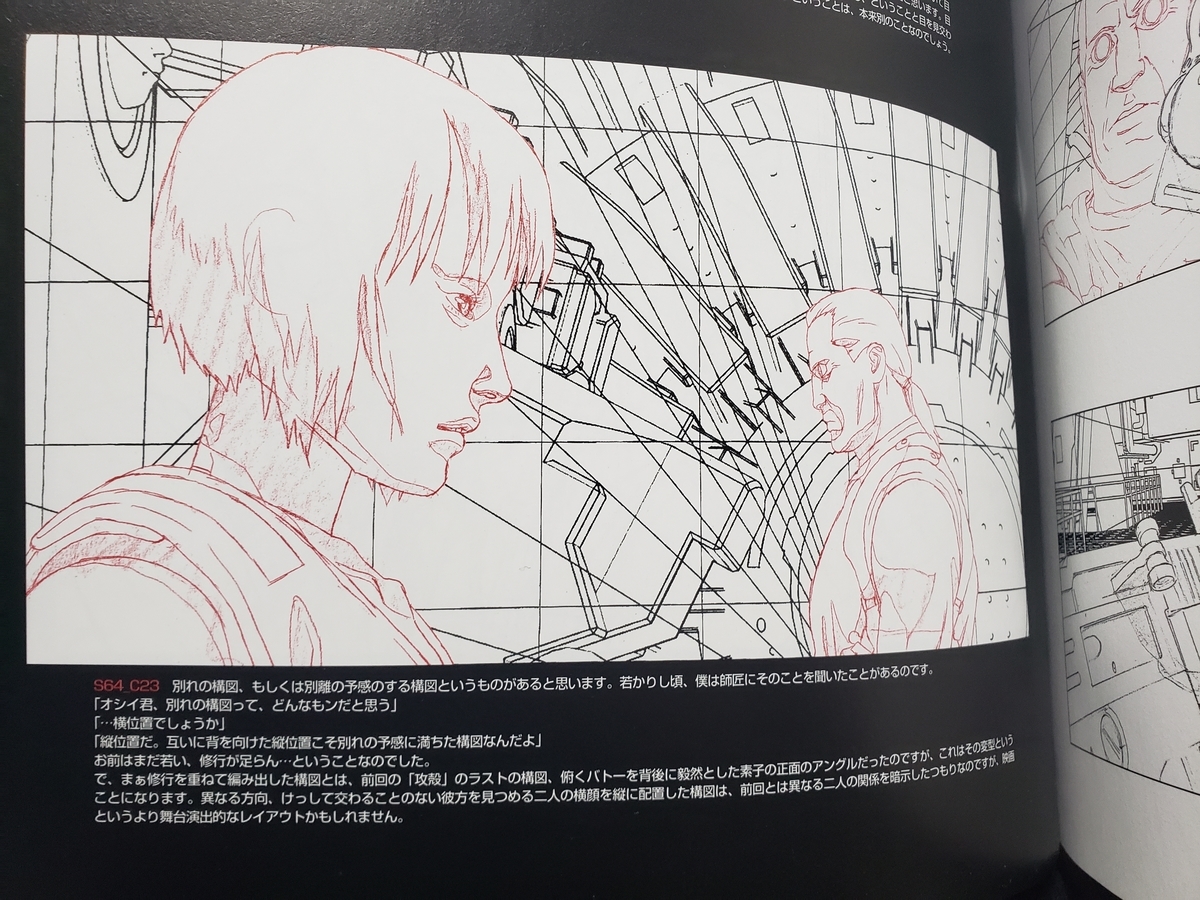
Oshii said the same thing in the audio commentary of INNOCENCE too. It looks like the "composition of separation" is a very important theme to him.
I suppose he might have asked Kawai to add the nuance of "separation" to the lyrics. That might be the reason why night birds appear in the lyrics.
GitS is a story of marriage/ spiritual fusion/ transcendence, but it also looks like Batou's tragic story to us. Kawai successfully or unintentionally expressed the two different story layers.
Conclusion
Utai is a song of encounter and separation, which is based on Kojiki, Nihon Shoki, and Manyoshu. As Oshii said in the liner notes, those materials perfectly fit the film's story. They also emphasize the feel of Shinto and ancient Japanese love stories.
In conclusion, I'd like to quote Oshii's words from the novelized version of Patlabor 2 the Movie:
出会うために別れるものもいれば、別れるために出会いを必要とするものもいる。
Some separate to meet another person, but others need an encounter even only to separate.
